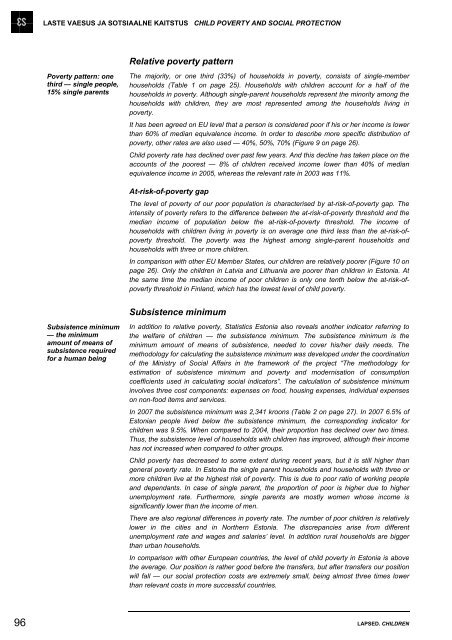LAPSED CHILDREN - Tartu Ãlikool
LAPSED CHILDREN - Tartu Ãlikool
LAPSED CHILDREN - Tartu Ãlikool
- No tags were found...
Create successful ePaper yourself
Turn your PDF publications into a flip-book with our unique Google optimized e-Paper software.
LASTE VAESUS JA SOTSIAALNE KAITSTUS CHILD POVERTY AND SOCIAL PROTECTION<br />
Relative poverty pattern<br />
Poverty pattern: one<br />
third — single people,<br />
15% single parents<br />
The majority, or one third (33%) of households in poverty, consists of single-member<br />
households (Table 1 on page 25). Households with children account for a half of the<br />
households in poverty. Although single-parent households represent the minority among the<br />
households with children, they are most represented among the households living in<br />
poverty.<br />
It has been agreed on EU level that a person is considered poor if his or her income is lower<br />
than 60% of median equivalence income. In order to describe more specific distribution of<br />
poverty, other rates are also used — 40%, 50%, 70% (Figure 9 on page 26).<br />
Child poverty rate has declined over past few years. And this decline has taken place on the<br />
accounts of the poorest — 8% of children received income lower than 40% of median<br />
equivalence income in 2005, whereas the relevant rate in 2003 was 11%.<br />
At-risk-of-poverty gap<br />
The level of poverty of our poor population is characterised by at-risk-of-poverty gap. The<br />
intensity of poverty refers to the difference between the at-risk-of-poverty threshold and the<br />
median income of population below the at-risk-of-poverty threshold. The income of<br />
households with children living in poverty is on average one third less than the at-risk-ofpoverty<br />
threshold. The poverty was the highest among single-parent households and<br />
households with three or more children.<br />
In comparison with other EU Member States, our children are relatively poorer (Figure 10 on<br />
page 26). Only the children in Latvia and Lithuania are poorer than children in Estonia. At<br />
the same time the median income of poor children is only one tenth below the at-risk-ofpoverty<br />
threshold in Finland, which has the lowest level of child poverty.<br />
Subsistence minimum<br />
Subsistence minimum<br />
— the minimum<br />
amount of means of<br />
subsistence required<br />
for a human being<br />
In addition to relative poverty, Statistics Estonia also reveals another indicator referring to<br />
the welfare of children — the subsistence minimum. The subsistence minimum is the<br />
minimum amount of means of subsistence, needed to cover his/her daily needs. The<br />
methodology for calculating the subsistence minimum was developed under the coordination<br />
of the Ministry of Social Affairs in the framework of the project “The methodology for<br />
estimation of subsistence minimum and poverty and modernisation of consumption<br />
coefficients used in calculating social indicators”. The calculation of subsistence minimum<br />
involves three cost components: expenses on food, housing expenses, individual expenses<br />
on non-food items and services.<br />
In 2007 the subsistence minimum was 2,341 kroons (Table 2 on page 27). In 2007 6.5% of<br />
Estonian people lived below the subsistence minimum, the corresponding indicator for<br />
children was 9.5%. When compared to 2004, their proportion has declined over two times.<br />
Thus, the subsistence level of households with children has improved, although their income<br />
has not increased when compared to other groups.<br />
Child poverty has decreased to some extent during recent years, but it is still higher than<br />
general poverty rate. In Estonia the single parent households and households with three or<br />
more children live at the highest risk of poverty. This is due to poor ratio of working people<br />
and dependants. In case of single parent, the proportion of poor is higher due to higher<br />
unemployment rate. Furthermore, single parents are mostly women whose income is<br />
significantly lower than the income of men.<br />
There are also regional differences in poverty rate. The number of poor children is relatively<br />
lower in the cities and in Northern Estonia. The discrepancies arise from different<br />
unemployment rate and wages and salaries’ level. In addition rural households are bigger<br />
than urban households.<br />
In comparison with other European countries, the level of child poverty in Estonia is above<br />
the average. Our position is rather good before the transfers, but after transfers our position<br />
will fall — our social protection costs are extremely small, being almost three times lower<br />
than relevant costs in more successful countries.<br />
96<br />
<strong>LAPSED</strong>. <strong>CHILDREN</strong>

















